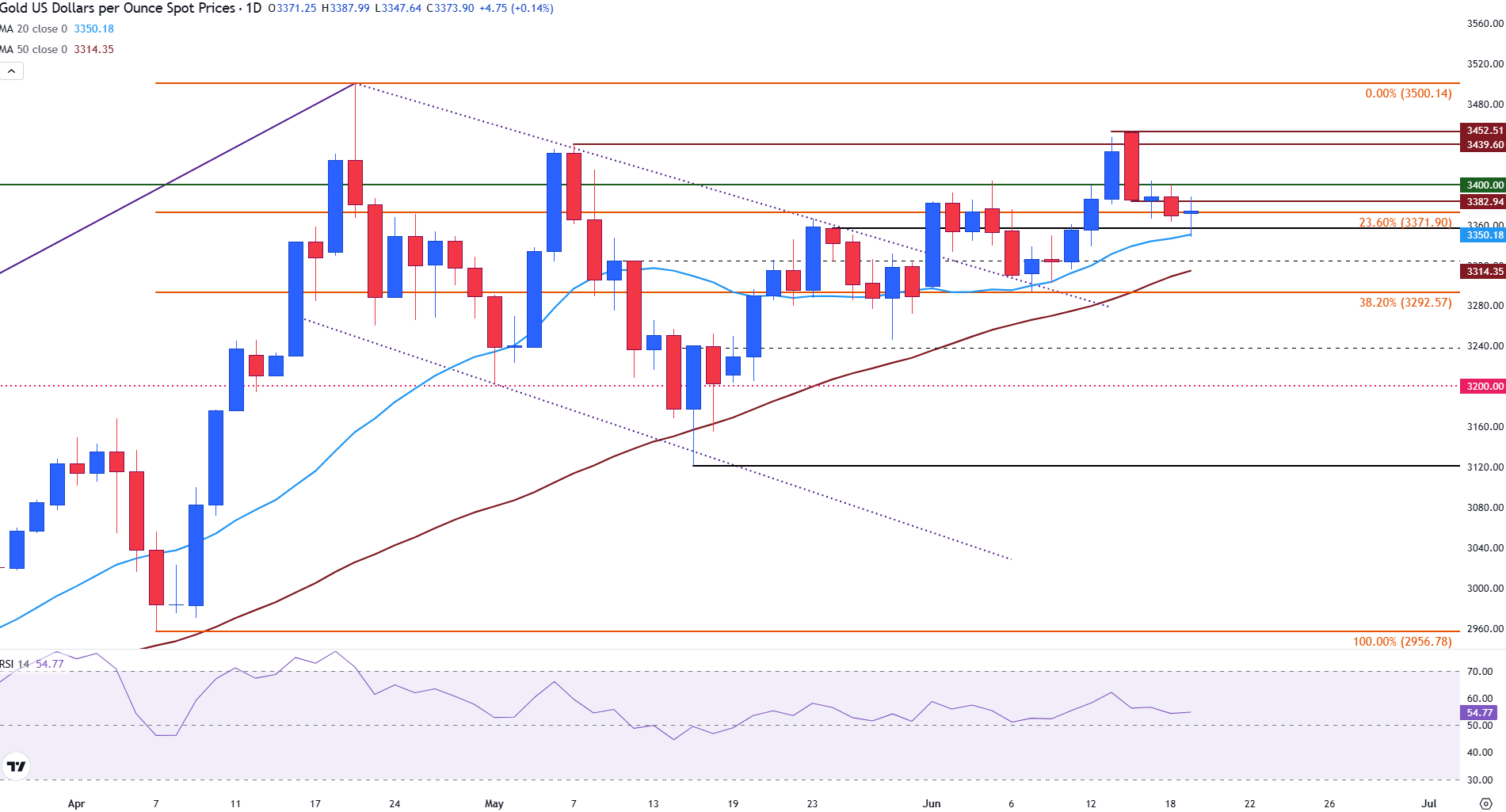Created
: 2025.06.19














![]() 2025.06.19 21:43
2025.06.19 21:43
Gold (XAU/USD) is trading within a well-defined range on Thursday, holding between $3,340 and $3,400. These levels have consistently acted as near-term support and resistance over the past week.
With the United States (US) observing the Juneteenth holiday, trading volumes remain light. Yet, key macro and geopolitical themes continue to shape the Gold price dynamics following the Federal Reserve's (Fed) latest policy announcement on Wednesday.
On Wednesday, the Fed kept its benchmark interest rate unchanged at the 4.25%-4.50% range, as expected. However, while the Federal Open Market Committee (FOMC)'s updated projections signaled two rate cuts by year-end, markets were surprised by Chair Jerome Powell's cautious tone during his press conference.
Gold initially benefited from the dovish rate outlook, with XAU/USD rising toward the $3,400 level, a key psychological barrier. However, Powell emphasized a data-dependent approach and reiterated concerns about inflation, which tempered enthusiasm for a rate cut and ultimately strengthened the US Dollar (USD), capping the intraday upside of XAU/USD.
While longer-dated US Treasury yields declined in response to the rate cut outlook, short-term yields rebounded as Powell struck a firmer tone, reflecting the Fed's ongoing caution in declaring victory over inflation.
Beyond monetary policy, the ongoing conflict between Israel and Iran continues to act as a potential upside risk for Gold. Growing speculation that the US may become directly involved militarily has heightened market concerns.
Any disruption to global Oil flows, particularly through the Strait of Hormuz, could reignite inflation fears and bolster demand for Bullion.
In this context, Gold continues to serve as a hedge against both geopolitical instability and the potential economic fallout from prolonged global tensions.
US President Donald Trump is scheduled to meet with the US National Security team on Thursday for the second meeting this week to discuss whether or not the US will increase its involvement in the Middle East tensions.
From a technical standpoint, the Fibonacci retracement drawn from the April low near $2,955 to the April high at $3,500 highlights several key levels that traders are closely watching.
At the time of writing, prices are currently trading around $3,365, with immediate resistance located at the 23.6% Fibonacci retracement of the April move, at $3,371. This level lies just above the 20-day Simple Moving Average (SMA) at $3,350, reinforcing the short-term significance of this zone.
For XAU/USD to resume along its upward trajectory, a break above $3,371 could open the door to the next level of psychological resistance at $3,400. Above that is the weekly high of $3,452, which could lead prices to the April record high of $3,500.
On the downside, a break of the 20-day SMA could bring the 50-day SMA into sight at $3,314 and toward another zone of psychological support at $3,300.
At the same time, the momentum of the bull trend is showing signs of easing with the Relative Strength Index (RSI) resting at 54, signalling a more neutral tone compared to the 60 reading seen last week.
Gold daily chart:

The US Dollar (USD) is the official currency of the United States of America, and the 'de facto' currency of a significant number of other countries where it is found in circulation alongside local notes. It is the most heavily traded currency in the world, accounting for over 88% of all global foreign exchange turnover, or an average of $6.6 trillion in transactions per day, according to data from 2022. Following the second world war, the USD took over from the British Pound as the world's reserve currency. For most of its history, the US Dollar was backed by Gold, until the Bretton Woods Agreement in 1971 when the Gold Standard went away.
The most important single factor impacting on the value of the US Dollar is monetary policy, which is shaped by the Federal Reserve (Fed). The Fed has two mandates: to achieve price stability (control inflation) and foster full employment. Its primary tool to achieve these two goals is by adjusting interest rates. When prices are rising too quickly and inflation is above the Fed's 2% target, the Fed will raise rates, which helps the USD value. When inflation falls below 2% or the Unemployment Rate is too high, the Fed may lower interest rates, which weighs on the Greenback.
In extreme situations, the Federal Reserve can also print more Dollars and enact quantitative easing (QE). QE is the process by which the Fed substantially increases the flow of credit in a stuck financial system. It is a non-standard policy measure used when credit has dried up because banks will not lend to each other (out of the fear of counterparty default). It is a last resort when simply lowering interest rates is unlikely to achieve the necessary result. It was the Fed's weapon of choice to combat the credit crunch that occurred during the Great Financial Crisis in 2008. It involves the Fed printing more Dollars and using them to buy US government bonds predominantly from financial institutions. QE usually leads to a weaker US Dollar.
Quantitative tightening (QT) is the reverse process whereby the Federal Reserve stops buying bonds from financial institutions and does not reinvest the principal from the bonds it holds maturing in new purchases. It is usually positive for the US Dollar.
![]()
Created
: 2025.06.19
![]()
Last updated
: 2025.06.19

FXStreet is a forex information website, delivering market analysis and news articles 24/7.
It features a number of articles contributed by well-known analysts, in addition to the ones by its editorial team.
Founded in 2000 by Francesc Riverola, a Spanish economist, it has grown to become a world-renowned information website.
We hope you find this article useful. Any comments or suggestions will be greatly appreciated.
We are also looking for writers with extensive experience in forex and crypto to join us.
please contact us at [email protected].
Disclaimer:
All information and content provided on this website is provided for informational purposes only and is not intended to solicit any investment. Although all efforts are made in order to ensure that the information is correct, no guarantee is provided for the accuracy of any content on this website. Any decision made shall be the responsibility of the investor and Myforex does not take any responsibility whatsoever regarding the use of any information provided herein.
The content provided on this website belongs to Myforex and, where stated, the relevant licensors. All rights are reserved by Myforex and the relevant licensors, and no content of this website, whether in full or in part, shall be copied or displayed elsewhere without the explicit written permission of the relevant copyright holder. If you wish to use any part of the content provided on this website, please ensure that you contact Myforex.
Myforex uses cookies to improve the convenience and functionality of this website. This website may include cookies not only by us but also by third parties (advertisers, log analysts, etc.) for the purpose of tracking the activities of users. Cookie policy